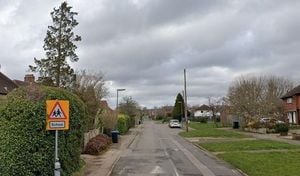Across both sides of the Atlantic, the crumbling state of public school buildings is drawing urgent attention from officials, educators, and communities. Recent reports from Northern Ireland and Maryland’s Montgomery County reveal a shared crisis: chronic underinvestment has left schools in disrepair, threatening the health, safety, and educational experiences of thousands of children and staff. With maintenance backlogs running into the hundreds of millions—and even billions—of pounds and dollars, the question is no longer whether to act, but how quickly and decisively authorities can marshal the resources to halt further decline.
In Northern Ireland, the scale of the problem is staggering. According to a report published on October 15, 2025 by Stormont’s Public Accounts Committee (PAC), more than 1,100 schools are grappling with a maintenance backlog estimated at between £600 million and £800 million. The committee’s findings, highlighted by BBC News NI, paint a bleak picture: “systemic failure in the management of Northern Ireland’s school estate” has resulted in overcrowded, poorly heated, and structurally failing buildings. The PAC did not mince words, warning that the condition of many schools "may pose a risk to the health and safety of pupils and staff."
The PAC’s report goes further, criticizing the Department of Education (DE) and the Education Authority (EA) for their "reactive short-term approach" to maintenance. Instead of a clear, proactive plan, officials have relied on patchwork solutions—an approach the committee called "an alarming example of poor governance," and one that is "unsustainable, ineffective and economically wasteful." The report recommends more frequent condition surveys of schools and the development of a comprehensive strategy, complete with an annual delivery plan from the Department of Education, to address the crisis.
Principals on the ground have echoed these concerns with stories of daily struggle. Emma Quinn, principal of Rathcoole Primary School in County Antrim, shared with BBC News NI, “As a leader, much of my day is spent chasing works, reporting leaks, faulty toilets, broken windows—whilst essential, this should not be my primary focus.” She added, “It’s unsettling that the backlog for maintenance and repair to our schools is still an ongoing concern. Schools amidst budget cuts, escalating complex needs, increased running costs are continually having to be creative in their everyday life in school to ensure high quality learning and teaching.” For Quinn and her colleagues, the funding for maintenance is “simply not there.”
Martin Moreland, principal of Mercy College in north Belfast, described the situation as “unacceptable.” He explained that while his school is in line for a new building, “getting there is probably going to be a 10-year journey.” In the meantime, he faces “ongoing and frequent problems with heating, lighting, very dimly lit rooms because of the old lights, leaks in roofs constantly.” Moreland recounted, “We had several incidents last year where the heating system broke down on really cold days.”
In response to the PAC’s findings, the Education Authority acknowledged the severe financial constraints facing the sector. In a statement, the EA said it welcomed the report, “which clearly reflects the scale of the financial challenges faced by the education sector.” The EA admitted that “recurring shortfalls in budgets mean that no funding is available for routine maintenance of the school estate,” and that only urgent repairs are currently undertaken. “This limited but unavoidable focus inevitably leads to deterioration in the condition of the estate.” Still, the EA said it was taking action regarding the £29 million statutory remedial backlog referenced in the report.
Education Minister Paul Givan also weighed in, saying, “I acknowledge the committee’s concerns and share its commitment to ensuring that every child in Northern Ireland is educated in a safe, modern, and inclusive environment. I value the report’s contribution in exposing the scale of the challenge, particularly the chronic underinvestment in our schools’ estate over many years.” Givan emphasized that the key issue is a lack of funding, especially acute in Special Educational Needs (SEN) provision, where the cost of emergency placements has soared from £9 million in 2019 to a projected £85 million this year—an 850% increase in just six years. He called for urgent, cross-party support to secure the necessary investment.
Meanwhile, in the United States, a similar drama is unfolding in Montgomery County, Maryland—one of the nation’s largest and most prominent school districts. On October 15, 2025, Montgomery County Executive Marc Elrich described the superintendent’s $2.7 billion Capital Improvements budget proposal as expensive but necessary, a reflection of "years of neglect." According to Montgomery Community Media, the proposal represents a $949 million increase over previous budgets, averaging $160 million more per year over six years. Elrich noted that current spending on capital improvements is about $280 million annually, which is substantially less than the inflation-adjusted $500 million spent in 2009. “Not funding [repairs] doesn’t make them go away,” Elrich warned. “In fact, it makes it worse … This requires a solution not more kicking down the road.”
Superintendent Thomas Taylor, presenting his proposed budget, was candid about the state of the district’s buildings. “Our facility condition is, in fact, declining,” he said. “And the sad part about this is that it’s not just declining, but it’s getting worse and worse and worse every year because the gap in the resources we have to fill is continuing to widen each year.” If nothing is done, Elrich cautioned, MCPS buildings and utilities will “further deteriorate.”
Adding to the complexity, MCPS is facing a decline in enrollment. In September 2025, the district reported 156,540 students, a decrease of 2,600 from the previous year. Elrich attributed this drop to a natural cycle influenced by declining birth rates and fewer immigrants, noting, “Part of it is going to be due to Trump’s actions around deportation where people either already have been deported or are worried about being deported or self deporting themselves before they get swept up.”
Both the Northern Ireland and Montgomery County cases underscore a global challenge: the consequences of deferred maintenance and underinvestment in public education infrastructure. The stories from principals and officials are remarkably similar—leaky roofs, faulty heating, and the constant struggle to keep old buildings safe and functional. The financial numbers may differ, but the underlying issues are the same: without sustained investment, the physical environments where children learn will continue to deteriorate, with far-reaching consequences for health, safety, and educational outcomes.
As policymakers on both sides of the Atlantic consider next steps, the message from educators and watchdogs is clear: creative budgeting and makeshift repairs can only go so far. The time for comprehensive, well-funded solutions is now—before another generation of students is left to learn in buildings that are, quite literally, falling apart.




